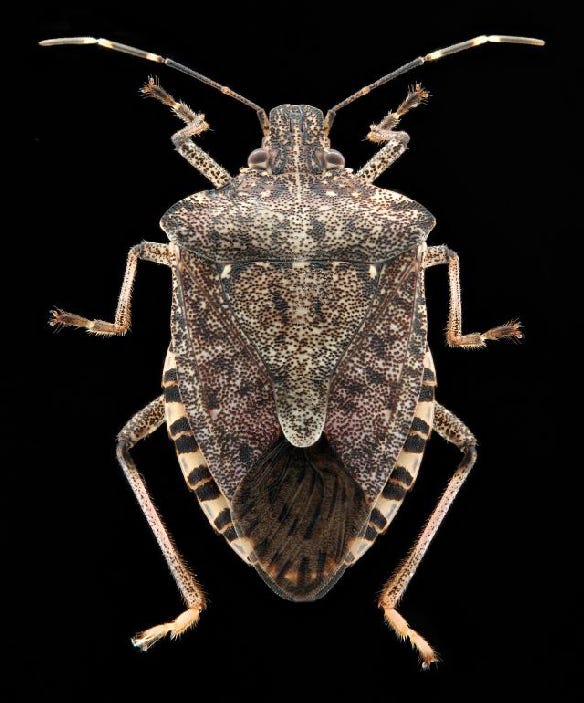
Kevin Rice notes “record-breaking calls” in Missouri from homeowners reporting brown marmorated stinkbugs invading homes for the winter. He says that is a bad sign for crop farmers.
“That's the historic pattern that we've seen in the past when this stinkbug started to invade the mid-Atlantic when it was first identified in Pennsylvania,” the University of Missouri Extension entomologist says. “We saw homeowners call us first, and then the populations built up, and then it spilled over into agriculture, and it caused extreme damage.
"That's where we are in the state of Missouri right now. The populations have increased, and we would expect this to be spilling over and causing pretty severe damage in agriculture in the next few years.”
History of yield loss
Rice, who worked in Pennsylvania, saw firsthand the destruction this invasive pest does to the agriculture industry.
The brown marmorated stinkbug first targeted fruit in the East. “It has that piercing, sucking mouthpart, so it also releases enzymes on its feed, so it causes this sort of quirky pattern that makes fruit unmarketable,” Rice explains. In fact, in the mid-Atlantic in 2011, the pest caused $37 million in losses to the apple industry alone. But the pest has a diverse palate.
In the East, Rice says, there are many smaller farms that are more diverse. “They grow a lot of fruit next to soybeans as well,” he explains. The brown marmorated stinkbug began feeding on soybeans and corn. He says growers were spraying almost daily to try to protect yields.
The same toxins released into fruits also are released into corn. The damage, in addition to creating a dent in the corn ear, is puncture wounds created during feeding that allow for mold to get in.
Rice is more concerned about the threat the brown marmorated stinkbug has for soybean farmers. “It creates flattened pods and reduces seed quality under extreme feeding that can actually cause seed abortions,” he explains. “But it also causes this stay-green syndrome along edges.”
The brown marmorated stinkbug prefers to feed along the edges of fields. Along these areas, plants don’t progress and remain green. “Those plants don’t dry down, and at harvest, we lose those plants as well,” Rice says.
The pest feeds on more than 300 host plant species and can cover a lot of area in a growing season. The brown marmorated stinkbug can fly more than 80 kilometers in one day, Rice says. “It is established throughout Missouri.”
Monitor pest movement
USDA discovered the pheromone that attracts and captures both male and female stinkbugs. Instead of using older pyramid traps that are expensive and can get in the way of farming equipment, there are now clear, sticky traps.
These are placed along the border of soybean fields and baited with the pheromone. University researchers tested sticky traps against net-sweeping fields, and found the numbers are the same for both high- and low-population scenarios.
“Our current research is moving toward, hopefully, developing a threshold using these sticky cards on the outside borders of soybean fields,” Rice says. “That's going to speed up the process, and these cards only cost $1 per unit. They are a lot easier than sweeping when it gets to those late-season soybeans when stinkbug numbers are really high.”
The good news, he notes, is university researchers have been studying this pest for 10 years and have a solid management plan, which includes a variety of insecticides. However, Rice has his sights set on a natural control option.
Helpful predatory insect
“We have this samurai wasp, which is the biological control agent for brown marmorated stinkbug,” he explains, “but the good news is this samurai wasp in Asia kills 90% of brown marmorated stinkbug eggs.”
The wasp is in the U.S. However, scientists did not bring it over or release it here. Rice says the wasp or its eggs likely came over on a shipment into the country.
“It’s a very effective killer of stinkbugs, and it's in 15 states now, making its way from New York and New Jersey to Ohio,” he says. “So, we would hope that it would continue to move westward, and as the population of stinkbugs increase that this will come behind them and provide some control as well.”
Until the samurai wasp appears in Missouri, the MU Extension entomologist says farmers need to scout fields and plan to use insecticides in 2021 to keep the brown marmorated stinkbug from causing damage to field and fruit crops.

BUG ID: The invasive brown marmorated stinkbug differs from the native stinkbug with its white markings on the body and antenna.
How to identify a brown marmorated stinkbug
The brown marmorated stinkbug was introduced to the U.S. from Asia in the mid-1990s and began its trek westward.
It is different from Missouri’s native brown stinkbug because it has white intestinal banding on the antenna. It also has white banding along the abdominal edges.
“This insect is an extreme generalist. It feeds on over 300 different host plant species,” Rice says. “It flies around a lot. They can actually fly over 80 kilometers in one day.”
It seeks out warm places to overwinter in the forest, typically under tree barks. But Rice says this insect also likes to find overwintering shelters in homes, sort of like ladybird beetles.
Farmers should scout corn and soybean fields this year for this invasive pest.
About the Author(s)
You May Also Like






